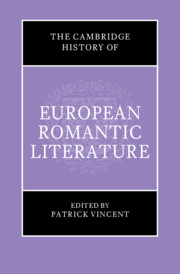Book contents
- The Cambridge History of European Romantic Literature
- The Cambridge History of European Romantic Literature
- Copyright page
- Contents
- Contributors
- Acknowledgements
- Note on the Text
- Chronology
- Introduction
- Part I Romantic Genealogies (1750–1790)
- 1 The Discovery of the Past
- 2 Discourses of Nature
- 3 The Romantic Sublime
- 4 Cultures of Sensibility
- 5 Gothic Circulations
- 6 The Crisis of Enlightenment
- Part II Revolution to Restoration (1790–1815)
- Part III Restoration to Revolution (1815–1850)
- Further Reading
- Index
4 - Cultures of Sensibility
from Part I - Romantic Genealogies (1750–1790)
Published online by Cambridge University Press: 10 January 2024
- The Cambridge History of European Romantic Literature
- The Cambridge History of European Romantic Literature
- Copyright page
- Contents
- Contributors
- Acknowledgements
- Note on the Text
- Chronology
- Introduction
- Part I Romantic Genealogies (1750–1790)
- 1 The Discovery of the Past
- 2 Discourses of Nature
- 3 The Romantic Sublime
- 4 Cultures of Sensibility
- 5 Gothic Circulations
- 6 The Crisis of Enlightenment
- Part II Revolution to Restoration (1790–1815)
- Part III Restoration to Revolution (1815–1850)
- Further Reading
- Index
Summary
The cultures of sensibility explored in Chapter Four authorised women to write, but as the chapter shows, the concept was equally influential among male writers, and contributed in significant ways to Romantic-period aesthetics, ethics, and politics. Eighteenth-century aesthetics reflected a new interest in the body and the senses. Like Romantic nature, Romantic sensibility is presented as a story of co-becoming, in this case between body and mind rather than between mind and nature. After discussing the difficulty of defining sensibility, the chapter provides a history of eighteenth-century neurophysiology, including the ground-breaking work of Haller, the electrical experiments of Galvani, and Bonnet’s invention of psychology. Steiner then turns to Rousseau to demonstrate the transition from medical to moral sensibility, and how sympathy operated as a central principle among Edinburgh’s moral sense philosophers. Sterne’s A Sentimental Journey helped spread moral sympathy across Europe, linking it with the feminisation of culture and with various reform movements, as shown in examples ranging from Chateaubriand to Jean Paul, a Danish anti-slavery narrative to the ‘Revolution debate’ in Britain. The chapter ends on an ambivalent note, using the Pygmalion motif to address the often-criticised connection between sensibility and narcissism.
- Type
- Chapter
- Information
- The Cambridge History of European Romantic Literature , pp. 135 - 161Publisher: Cambridge University PressPrint publication year: 2023

